GMRC Review: The Stars, Like Dust by Isaac Asimov
 Guest Blogger, Allie McCarn, reviews science fiction and fantasy books on her blog Tethyan Books which we featured in a previous post: Five SF/F Book Blogs Worth Reading. She has contributed many great book reviews to WWEnd and has generously volunteered to write some periodic reviews for our blog. This is Allie’s second GMRC review.
Guest Blogger, Allie McCarn, reviews science fiction and fantasy books on her blog Tethyan Books which we featured in a previous post: Five SF/F Book Blogs Worth Reading. She has contributed many great book reviews to WWEnd and has generously volunteered to write some periodic reviews for our blog. This is Allie’s second GMRC review.
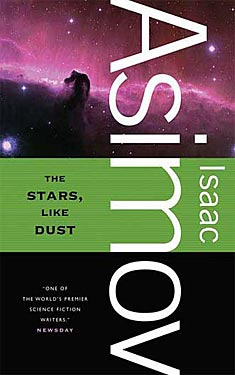 The Stars, Like Dust by Isaac Asimov
The Stars, Like Dust by Isaac Asimov
Published: Doubleday, 1951
Series: The Galactic Empire Book 2
The Book:
“Biron Farrell was young and naïve, but he was growing up fast. A radiation bomb planted in his dorm room changed him from an innocent student at the University of Earth to a marked man, fleeing desperately from an unknown assassin.
He soon discovers that, many light-years away, his father, the highly respected Rancher of Widemos, has been murdered. Stunned, grief-stricken, and outraged, Biron is determined to uncover the reasons behind his father’s death, and becomes entangled in an intricate saga of rebellion, political intrigue, and espionage.
The mystery takes him deep into space where he finds himself in a relentless struggle with the power-mad despots of Tyrann. Now it is not just a case of life or death for Biron, but a question of freedom for the galaxy.” ~barnesandnoble,com
I’ve been a big fan of Asimov’s work, ever since I discovered I, Robot as a kid. I’ve since read the majority of his novels and short stories, but I’d never read any of this particular trilogy (Pebble in the Sky, The Stars, Like Dust, and The Currents of Space). Thus, when I saw The Stars, Like Dust in a used bookstore, I grabbed it. If I’d done a little research first, I suppose that I would have discovered Asimov has apparently referred to this one as his “least favorite novel.” In any case, it’s an interesting look at a lesser, early novel of Asimov’s. The Stars, Like Dust, contains a standalone story, so I don’t think the novels that comprise this trilogy need to be read in order.
Sadly, there won’t be much more Asimov featured on my blog, only because I’ve pretty much read most of his work, and I don’t generally re-read. If you really want to get into Asimov (and who wouldn’t?), his robot short stories are a good place to start.
My Thoughts:
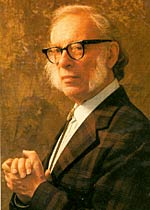 The Stars, Like Dust seems like a pretty typical pulp SF adventure story. There’s an evil empire (the Tyranni), a plucky young hero with a crew cut and well-trained muscles (Biron), a secret rebellion, a feisty love interest (a pretty girl named Artemisia), and even a helpful old inventor. Most of the details of the plot, and the various twists, seem pretty clichéd, though I imagine that might not have been the case back when it was published.
The Stars, Like Dust seems like a pretty typical pulp SF adventure story. There’s an evil empire (the Tyranni), a plucky young hero with a crew cut and well-trained muscles (Biron), a secret rebellion, a feisty love interest (a pretty girl named Artemisia), and even a helpful old inventor. Most of the details of the plot, and the various twists, seem pretty clichéd, though I imagine that might not have been the case back when it was published.
The characters do little to break out of their one dimensionality. Artemisia has little to do in the story besides fall for the hero; she’s an aristocrat on the run from her arranged marriage with a powerful older man. Biron is the typical naïve, ignorant young man who ends up being somehow vastly more capable—physically and mentally—than everyone around him. It doesn’t help that the writing itself also seems clunky, and the dialogue doesn’t seem to flow naturally. There is also a rather ridiculous subplot about mysterious ‘important Earth document’, which I have heard was added against Asimov’s will.
If you’re willing to go along with a fair amount of cheesiness, however, the story is pretty fun. I think that The Stars, Like Dust is clearly one of many similar stories that contributed to the imagining of Star Wars, though this earlier novel misses some of the strengths in plot and character that made Star Wars such a cultural phenomenon. The Stars, Like Dust, is a fast read, and I kind of enjoyed reading such an example of campy 50’s Sci-Fi.
My Rating: ~/5
The truth is, I don’t want to rate this novel. Therefore, I won’t. I can’t in good conscience say it is a good novel. However, I did enjoy it, at least as a glimpse into Asimov’s earlier, lesser-known work. This is also, apparently, Asimov’s least favorite novel, so it was interesting to see what he considers the worst of his large and mostly impressive body of work. I think The Stars, Like Dust is a novel that would mostly appeal to Asimov completionists, though it’s also a fun, short little novel for anyone who wants a dose of good-natured, corny, 50s-style, pulp SF star-spanning adventure.
Forays into Fantasy: The Well of the Unicorn by Fletcher Pratt
Scott Lazerus is a Professor of Economics at Western State College in Gunnison, Colorado, and has been a science fiction fan since the 1970s. Recently, he began branching out into fantasy, and was surprised by the diversity of the genre. It’s not all wizards, elves, and dragons! Scott’s new blog series, Forays into Fantasy, is an SF fan’s exploration of the various threads of fantastic literature that have led to the wide variety of fantasy found today. FiF will examine some of the most interesting landmark books of the past, along with a few of today’s most acclaimed fantasies, building up an understanding of the connections between fantasy’s origins, its touchstones, and its many strands of influence.
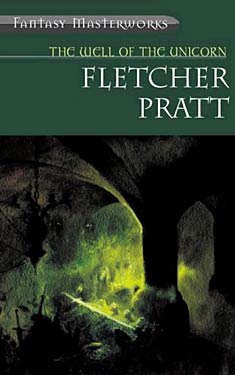 Fletcher Pratt, a military historian with a background in journalism and linguistics—he also worked as a translator—is best known to fantasy readers for his many collaborations with L. Sprague de Camp, especially the sequence of Harold Shea stories collected as The Incompleat Enchanter (1941). Earlier, he had published stories in Hugo Gernsback’s science fiction pulps as early as 1928. The Well of the Unicorn (1948) is one of two fantasy novels published by Pratt. The second, The Blue Star, came out in 1952, and neither was commercially successful, which may be why he abandoned the genre. According to James Cawthorn and Michael Moorcock, who include this novel in their Fantasy: The 100 Best Books, the publisher insisted that Pratt use a pseudonym (George U. Fletcher) to protect his reputation as a serious historical writer (although the de Camp collaborations had already been appearing under his own name), and the book flopped upon release, the publisher going out of business soon thereafter. Revived later as a paperback reprint, the book has gained in reputation since, lauded by Cawthorn and Moorcock along with David Pringle (it’s third chronologically in his Modern Fantasy: The Hundred Best Novels) and being reprinted in 2001 as part of the Fantasy Masterworks series.
Fletcher Pratt, a military historian with a background in journalism and linguistics—he also worked as a translator—is best known to fantasy readers for his many collaborations with L. Sprague de Camp, especially the sequence of Harold Shea stories collected as The Incompleat Enchanter (1941). Earlier, he had published stories in Hugo Gernsback’s science fiction pulps as early as 1928. The Well of the Unicorn (1948) is one of two fantasy novels published by Pratt. The second, The Blue Star, came out in 1952, and neither was commercially successful, which may be why he abandoned the genre. According to James Cawthorn and Michael Moorcock, who include this novel in their Fantasy: The 100 Best Books, the publisher insisted that Pratt use a pseudonym (George U. Fletcher) to protect his reputation as a serious historical writer (although the de Camp collaborations had already been appearing under his own name), and the book flopped upon release, the publisher going out of business soon thereafter. Revived later as a paperback reprint, the book has gained in reputation since, lauded by Cawthorn and Moorcock along with David Pringle (it’s third chronologically in his Modern Fantasy: The Hundred Best Novels) and being reprinted in 2001 as part of the Fantasy Masterworks series.
The plot will strike today’s readers as a fantasy standard: A young man—the protagonist Airar Alvarson—is unjustly removed from his family’s land by the Vulkings, who are consolidating their power and influence throughout the land of Dalarna, which is occupied by a number of different ethnic groups, including the Delacarles, Airar’s people, all of whom submit to an Empire which seems to be very decentralized (similar to the power of kings in early feudal Europe) and therefore not directly present to influence these events. Airar must set out into the world to find a living, but is soon waylaid by a talking owl, who leads him to the home of the wizard Meliboë, who offers Airar some gold to take a message to a band of conspirators (the “Iron Ring”) who are planning to fight back against the Vulkings’ depradations. Airar falls in with this group and, as the story progresses and the uprising grows, eventually becomes a military leader of the movement as he demonstrates his leadership abilities and tactical skill, a development foreseen by Meliboë. Along the way, he helps bring together various factions within Dalarna to resist the Vulkings—factions who normally would not be interested in cooperation, due to their differing social philosophies. As the story progresses, Airar matures into a leader, explores Dalarna with an eye to how its various societies work, and sets his heart on the Princess Argyra.
It sounds like a stock fantasy plot, but it must be kept in mind that this novel is prior to The Lord of the Rings, and the subsequent deluge of similar multi-volume quest/coming-of-age narratives. L. Sprague de Camp maintained that Pratt was influenced by Eddison’s The Worm Ouroboros, and Pratt himself points to Lord Dunsany as a precursor. Pratt borrows some of Dalarna’s history from Dunsany’s play “King Argimenes and the Unknown Warrior” though, as Pratt points out in his Author’s Note, “the events he cites took place generations before any told here, and he was only interested in a very small part of them.” The Well of the Unicorn, then, is a very early example of the “secondary world” fantasy—a fantasy set in a world that doesn’t exist, and to which (unlike, for example, Oz or Narnia), there is no access from our world. If modern readers find the premise familiar, it is because they have subsequently absorbed decades of this type of fantasy, though it would have seemed quite novel in 1948. (It would be interesting to know if Tolkien read Pratt’s fantasies.)
Though the plot (and to some degree the setting) will seem familiar to today’s fantasy readers, other aspects will come across as more unusual. The novel is quite long and complex, and is full of philosophical conflicts and discussions, to the point where it’s likely that modern fantasy fans might be impatient with the lack of action and forward movement, despite the fact that the story is based around a series of military campaigns. Airar, who has been “taxed out” of his land, along with many of his countrymen, by the Vulkings, becomes interested in why some societies are more successful than others. In particular, he explores the tradeoff between individual freedom and social order and discipline. The main contrast in his mind is between the Vulkings, who promote the most able individuals to positions of power, while enforcing rigid military discipline (ancient Rome could be the model), and the Carrhoene people of the Twelve Cities, who have a hereditary class-based system, in which individuals are raised to take on the positions they will ultimately hold in their society (as in feudal Europe). Airar’s own Delacarle people are more devoted to individual freedom and self-sufficiency (reminiscent of America in the colonial period), but lack the organization to resist the rule of the Vulkings. He also considers the freebooting “free city” of Os Erigu as a model. As Meliboë explains it to him:
For see—all’s well to be free and labor together (this is the thought forward on which you look, I take it); all’s well when it’s a matter of two or three to build a byre or hunt a bear, but when there are foemen in the land or something other where each man cannot see for himself what’s to be done, why then all must take the guidance of a man they never have seen nor perhaps heard on… So there’s your government permanent and paramount with authority atop and confidence below, and I know no ways of keeping it so but the ways of Briella [home city of the Vulkings] and Carhoenne. Ah, you’ll find tricks and devices, given names in the books—that is what books are for, to call names—but it comes to the same in the end… In either, those below are less than free.
Airar is not convinced. Instead, he develops the capacity to see the good and bad in the different societies (including those he considers enemies) in determining how to rule in a way that allows for authority when needed and freedom whenever possible. Since his own authority is derived from the respect from those who follow him, and his own respect for them, he seems on the way to doing his best to resolve a dilemma that can never entirely be solved.
 This is also a novel in which war is interrogated. Airar starts out young and inexperienced, with a romantic vision of war and a willingness to do whatever it takes to get revenge on the Vulkings. But on seeing a comrade speared through the throat in his first taste of conflict, “Airar went sick in the realization that war was no dainty sport as he had been taught, but horror and pain and the death of friends.” He cannot take joy in destruction, even of those whom he believes must be destroyed. But peace may also be a mirage, as represented by the titular Well of the Unicorn, a place of magical and religious significance controlled by the Empire. Those who partake of the Well are supposed to realize peace, but the four tales of the Well interspersed throughout the story (all told second-hand), seem to indicate that those who drink from it do not necessarily end up better off because of it.
This is also a novel in which war is interrogated. Airar starts out young and inexperienced, with a romantic vision of war and a willingness to do whatever it takes to get revenge on the Vulkings. But on seeing a comrade speared through the throat in his first taste of conflict, “Airar went sick in the realization that war was no dainty sport as he had been taught, but horror and pain and the death of friends.” He cannot take joy in destruction, even of those whom he believes must be destroyed. But peace may also be a mirage, as represented by the titular Well of the Unicorn, a place of magical and religious significance controlled by the Empire. Those who partake of the Well are supposed to realize peace, but the four tales of the Well interspersed throughout the story (all told second-hand), seem to indicate that those who drink from it do not necessarily end up better off because of it.
The role of magic in the novel is also unusual. As the Science Fiction Encyclopedia puts it, the world of the novel is “subtly irradiated” by magic. Its power is questionable, its results (as with the magical Well) may be unpredictable, and its use has consequences. Airar himself was trained by his father in magic, but the more he explores it, the less he desires to use it. It is physically draining, and Airar sees it as making him weak rather than strong. He would much prefer to show his capabilities as a man through real accomplishments, especially in battle, and by the end of the story shows no indication of using magic again. In fact, despite the existence of magic in the world of The Well of the Unicorn, it is very realistic for a fantasy novel. Dalarna could be Northern Europe during the early Middle Ages, the magic could be replaced by myth, and the story would be little altered. The battles depicted are based around realistic military tactics rather than magic. Magic in the story seems to be presented as something that the people of Darlarna might be better off without, representing a crutch by which some would avoid taking the real actions needed to deal with difficult situations. But this aspect, as with much else in the novel, is quite ambiguous.
While, as I have tried to indicate, there is much of interest in this novel, and its critical acclaim is understandable, it’s not surprising that it’s not better known and more popular. In a genre where exciting plot and intricate world building are prized, this is a novel in which the world is not especially original (it could be northern Europe in the early Middle Ages and nothing would need to change but the place names), and the plot bogs down for chapters at a time as the characters discuss strategy and debate philosophy. Pratt’s use of archaic-sounding language is also off-putting. Meliboë’s speech quoted above gives a sense of how the language style makes continuous use of odd sentence structures—objects placed before subjects, invented pronouns and contractions—making it very difficult to follow without maintaining strong concentration on the reading. Pratt, being a linguist, may have based this strange grammar on ancient or foreign language structures, but I don’t know this for certain. This helps to create an unusual sense of place and mood, but it becomes tiresome over the three-hundred-plus pages of the novel. The novelty quickly wears off, and it soon becomes an impediment to becoming immersed in the story.
The Well of the Unicorn, then, is an interesting chapter in the history of fantasy literature, and certainly has its rewards, but is not likely to appeal much to today’s readers of fantasy. It seems to resist the fantastic aspects, just as Airar resists the call of magic. It raises many questions, but leaves most unanswered. One possibility is that Fletcher Pratt was using a fantasy novel to call into question the appeal of fantasy itself to the human imagination.
Next time I’ll be looking at The House on the Borderland by William Hope Hodgson, a Fantasy Masterwork from 1908. It’s a precursor to the sort of "weird tale" that would be popularized later by H. P. Lovecraft and others. You’re all invited to read along!
GMRC Review: Virtual Unrealities by Alfred Bester
 Guest Blogger and WWEnd Member, Matt W. (Mattastrophic), reviews science fiction and fantasy books on his blog Strange Telemetry. Matt is a regular WWEnd contributor and he won the January GMRC Review of the Month for his review of The Dispossessed.
Guest Blogger and WWEnd Member, Matt W. (Mattastrophic), reviews science fiction and fantasy books on his blog Strange Telemetry. Matt is a regular WWEnd contributor and he won the January GMRC Review of the Month for his review of The Dispossessed.
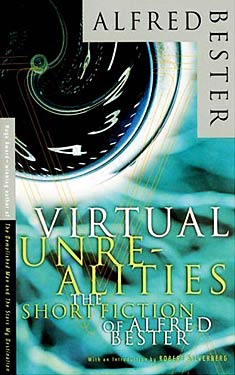 Alfred Bester is one writer who kind of did it all during his lifetime: science fiction, mainstream magazines, comics, television, stage, film etc., etc. In the SF community he is best known for his two novels The Demolished Man (which won the first Hugo award in 1953) and the equally dazzling The Stars My Destination (1956), both of which are amazing works that should be a part of everyone’s SF reading list. Amazing though they are, they certainly show their age. Bester did his best work in SF during the 1950s, while short fiction was still the lifeblood of the form, authors were paid by the word, and now-tired cliches were pursued with unabashed glee. The 1950s produced some great SF, to be sure, but it also produced drek that is perhaps best consumed as the target of lampooning in an episode of MST3K. Virtual Unrealities is a collection of Bester’s short work, which runs the gamut between amazingly engaging and…uh… not. Bester’s tendency to run between genius and drek is clearly outlined in Robert Silverberg’s essential introduction to the work, in which he includes a very telling quote from Damon Knight:
Alfred Bester is one writer who kind of did it all during his lifetime: science fiction, mainstream magazines, comics, television, stage, film etc., etc. In the SF community he is best known for his two novels The Demolished Man (which won the first Hugo award in 1953) and the equally dazzling The Stars My Destination (1956), both of which are amazing works that should be a part of everyone’s SF reading list. Amazing though they are, they certainly show their age. Bester did his best work in SF during the 1950s, while short fiction was still the lifeblood of the form, authors were paid by the word, and now-tired cliches were pursued with unabashed glee. The 1950s produced some great SF, to be sure, but it also produced drek that is perhaps best consumed as the target of lampooning in an episode of MST3K. Virtual Unrealities is a collection of Bester’s short work, which runs the gamut between amazingly engaging and…uh… not. Bester’s tendency to run between genius and drek is clearly outlined in Robert Silverberg’s essential introduction to the work, in which he includes a very telling quote from Damon Knight:
Dazzlement and enchantment are Bester’s methods. His stories never stand still a moment; they’re forever tilting into motion, veering, doubling back, firing off rockets to distract you…Bester’s science is all wrong, his characters are not characters but funny hats; but you never notice: he fires off a smoke bomb, climbs a ladder, leaps from a trapeze, plays three bars of “god Save the King,” swallows a sword and dives into three inches of water. Good heavens, what more do you want?
Knight hits the nail on the head here, and I really identified with his critique of Bester’s characters as merely funny hats. Most of his characters are placeholders, archetypes, and cardboard cutouts about as interesting as the paper they are printed on: they’re fairly flat, tend toward extremes, and demonstrate disturbing lack of incredulity given their situations. Take “Star Light, Star Bright” for example: when a man tells you he’s hunting for a family of missing geniuses who can defy the laws of physics and he is going to let you in on the money he can make exploiting them, you should at least make an honest effort at being skeptical before negotiating your share. Still, he can be lauded for the fact that his stories never stand still, and he plays the showman enough that, if you can run with him far enough to get where he wants you to go, there are some neat surprises in store (most of the time).
The Good, The Bad, The Psychotic, and the Overly-Credulous
Bester’s short fiction isn’t about hard science, rather it speculates about wild ideas taken to their extremes with some science thrown in (you know, for credibility’s sake). Given the loosey-goosey nature of the science, some of the stories almost read as contemporary fantasy, but I think of them closer as fantasies: extreme tales about desire, disappointment, frustration, anger, resentment, and high energy. I can imagine Bester as a showman in a flashy suit with a light-up tie clapping his hands together with a sharp, resounding crash as he leans in to a rapt audience and says “Ok, let’s see what you think of THIS one” before starting in frenetically with barely a breath between lines.
Of course, this frenetic energy meant that many of these stories are exhausting, and I found myself skipping around the book quite a bit as one story or another tried my endurance a mite too far. Each time I found myself skipping over the rest of a story because it drained me of energy (or interest), however, I would become instantly committed to another by the energy in its opening lines alone. For instance, I became utterly bored with the first story in the collection only to turn to the next (“Oddy and Id”) and be immediately sucked in by the first line: “This is the story of a monster.” When I became bogged down in the story “5,271,009,” I skipped ahead a bit and became immediately sucked in with the opener of his psychoanalytic gem “Fondly Fahrenheit”: “He doesn’t know which of us I am these days, but they know one truth. You must own nothing but yourself. You must make your own life, live your own life, and die your own death…or else you will die another’s.” This is really a testament to Bester’s ability to start a story at breakneck speed and use the resulting vortex to suck you into it.
While most of the stories in this collection begin with energy and intrigue you can feel on down to your toes, the endings vary in depth and overall effect. You can tell he’s trying to shoot the moon every time and end with pizazz. Bester’s not after a meditative hmmmm from his readers as he is a thunderous, involuntary AHA! or a long, ominous Oooohhh! Poe’s notion of “unity of effect” is applicable here. For Poe, all elements of a work of fiction should be unified in supporting the emotion or reaction that the author wants to elicit from the reader. Bester’s short work seems to exemplify unity of effect as all elements of these stories move towards a unified emotion or singular revelation in the climax. That there is really no denouement to speak of in Bester’s stories, which further indicates that the climactic AHA! moment is the point of the story. Sometimes this works out great, as in “Oddy and Id” where several scientists figure out that a young student of theirs has the power to make his unconscious desires come true. They struggle with whether or not to make the young man, Oddy, explicitly aware of this gift since until that point, while he was unaware of this gift, his actions have all been good. The climax of this story is one that stays with you for a while and works on your brain in intriguing ways, and it one of the best examples of Bester’s ability to dazzle in a conclusion.
In other works, however, the impact of that climactic moment or emotion is more akin to a fizzle than a bang. “Of Time and Third Avenue,” for example, is a predictable and ho-hum affair where a man from the future attempts to convince a man from the past to relinquish an almanac that would tell him what the future holds. The story is built around a revelation that, to my 21st century eyes at least, isn’t all that exciting and seems like it would have been overdone even at the time of its publication. That the man from the past demonstrated only the most token bit of incredulity regarding the possibility of time travel and an almanac from the future is typical Bester. He doesn’t have the time to thoroughly develop characters beyond “funny hats” or archetypes, so stories like this mean that you need to hold on to your suspension of disbelief with both hands as you read. “Star Light, Star Bright” was another fizzle for me. It slowly pulled me into an intriguing mystery involving a missing family of geniuses, but in the end it just didn’t have the payoff to make it worth the effort. The entire story felt retroactively deflated the moment I read its climax; one of those “awww, come on!” moments that make you feel silly for being invested in the plot in the first place. Bester is the consummate showman, and all of the stories in this collection are geared towards that big finish, although sometimes it fails to dazzle.
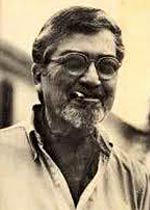 Where Bester seems to be in top form, and where his characterization is most compelling, is when writing about monsters: bad men who either make the choice to be bad or are helplessly compelled to do bad things. The protagonists of both The Demolished Man and The Stars My Destination are both wicked men (kill-your-family wicked, not fun-to-drink-with wicked), which is part of what makes them so appealing and so surprising for SF in the postwar era of the 1950s. Bester’s affinity for writing compelling monsters comes out in several stories in this collection. In “Fondly Fahrenheit” for example, a man who has never done a lick of work in his life finds himself relying on his family’s advanced, super-expensive android, and when that android ends up killing people his solution is to run away with it, as it is his only asset in the world, instead of reporting the incident and taking responsibility. “Pi Man” features a character who murders someone he likes and beats his own dog to death for no reason he can adequately explain to us or others (he’s at the whims of the cosmos), but by the end of the story even this monster is rendered sympathetic. Sometimes the compulsion or choice to do bad or evil things is funny (in the absurdist tradition), as in “The Man Who Murdered Mohammed” where a mad scientist finds his wife cheating on him and, instead of confronting her, he decides to build a time machine to go back in time and kill his wife’s mother (thereby wiping said wife out of existence) with…unexpected results. Sometimes it’s truly frightening, as in “Oddy and Id,” where we must conclude that the monster in the protagonist Oddy is no worse than the monster lurking in our own unconscious.
Where Bester seems to be in top form, and where his characterization is most compelling, is when writing about monsters: bad men who either make the choice to be bad or are helplessly compelled to do bad things. The protagonists of both The Demolished Man and The Stars My Destination are both wicked men (kill-your-family wicked, not fun-to-drink-with wicked), which is part of what makes them so appealing and so surprising for SF in the postwar era of the 1950s. Bester’s affinity for writing compelling monsters comes out in several stories in this collection. In “Fondly Fahrenheit” for example, a man who has never done a lick of work in his life finds himself relying on his family’s advanced, super-expensive android, and when that android ends up killing people his solution is to run away with it, as it is his only asset in the world, instead of reporting the incident and taking responsibility. “Pi Man” features a character who murders someone he likes and beats his own dog to death for no reason he can adequately explain to us or others (he’s at the whims of the cosmos), but by the end of the story even this monster is rendered sympathetic. Sometimes the compulsion or choice to do bad or evil things is funny (in the absurdist tradition), as in “The Man Who Murdered Mohammed” where a mad scientist finds his wife cheating on him and, instead of confronting her, he decides to build a time machine to go back in time and kill his wife’s mother (thereby wiping said wife out of existence) with…unexpected results. Sometimes it’s truly frightening, as in “Oddy and Id,” where we must conclude that the monster in the protagonist Oddy is no worse than the monster lurking in our own unconscious.
“Oddy and Id” is a good example of Bester’s fascination with psychology, particularly Freudian psychoanalysis, which played a pervasive role in his Hugo-award winning The Demolished Man. We could do strong Freduian readings of most stories in this collection, particularly “Time is the Traitor” which involves an investigation into the trauma of The Decider (no, not George Bush) who despite an almost prescient ability to predict the future (affecting the lives of billions and making him the richest, most powerful man ever) has the inexplicable compulsion to kill any and every man named Kruger that he comes across. While psychology has moved beyond Freud in many/most ways–which certainly doesn’t help the already-precarious way in which Bester’s work has aged–it nevertheless is appealing since it allows Bester to tap into and play with the unpredictable forces of the mind and make seemingly malevolent characters seem sympathetic and understandable to a degree. These characters visibly struggle with their desires, and those stories are where Bester’s characters are the closest to being actual characters instead of funny hats (funny like an over-the-top Derby hat).
I would also draw attention to another endearing bit of Bester’s experimentation: how he plays with the way words sit on the page. Occasionally he will often draw pictures using words that require you to read the page in a different way, to re-orient yourself to the story, or just to thumb you in the eye and defy your expectations. This was a pretty avant garde move for Bester in the 50′s and 60′s, predating the most experimental Language Poets (who also played with typeset and the form of words on the page) by at least a decade or two.
The Best of Bester?
In some ways, Bester was very much ahead of his time, and in others he was of it, which is one reason his fiction has dated pretty hard. If you know how to approach his work, however, you can look past its datedness (to a degree) and see the unbridled play going on underneath. It’s not without its problems, however. Virtual Unrealities is a collection that shows both sides of Bester: the frenetic genius and the trite, cliched stuff. Some of his stories are fun, others are haunting, and yet others have all the luster of a poorly-planned and poorly-timed joke. Silverberg, however, rightly notes in his forward that all of them–the good and the bad–are crackling with the energy, enthusiasm, and showmanship that was Bester’s hallmark. If you read this collection for the razzle and the dazzle, knowing in advance that it has aged hard and that he is shooting not for meditation but a unity of effect that privileges that AHA! moment at the end, then you too can have some fun with Virtual Unrealities, as I did.
GMRC Review: Farmer in the Sky by Robert A. Heinlein
 Jeremy Frantz (jfrantz) reviews SF/F books on his blog The Hugo Endurance Project where he has given himself just 64 weeks to read every Hugo Award winner. This is his third GMRC review.
Jeremy Frantz (jfrantz) reviews SF/F books on his blog The Hugo Endurance Project where he has given himself just 64 weeks to read every Hugo Award winner. This is his third GMRC review.
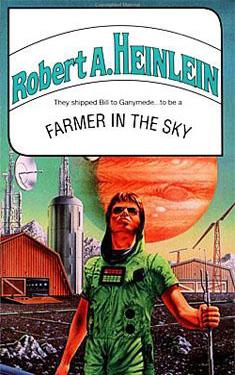 Farmer in the Sky is a YA title, of which Heinlein wrote over a dozen, and this was my first. Here, Bill Lermer and his father, George, have applied for permission to emigrate to Ganymede, the third moon of Jupiter. We follow them on their trip out and as they navigate the hardships of colonizing and farming the harsh moon’s lava-encrusted landscape and also deal with the occasional life-threatening disaster millions of miles from Earth.
Farmer in the Sky is a YA title, of which Heinlein wrote over a dozen, and this was my first. Here, Bill Lermer and his father, George, have applied for permission to emigrate to Ganymede, the third moon of Jupiter. We follow them on their trip out and as they navigate the hardships of colonizing and farming the harsh moon’s lava-encrusted landscape and also deal with the occasional life-threatening disaster millions of miles from Earth.
So (not) Heinlein
This is Heinlein’s second Hugo winner of the 1950’s, after Double Star (1956), (first technically, but it was a retro) and if there is anything similar about these two novels, it is the characters. They are the kind of people that no one really is, but everyone identifies as the kind of person they are or would like to be. Bill is just one of those characters (George too, but who cares about George really). I was sorry I didn’t read this book at a younger age because Bill was totally one of those characters who I would have tried so hard to emulate…and would have been so sad when I didn’t.
Apart from the characters, the style of the rest of the book was rather dry and straightforward and generally subdued compared to any of Heinlein’s other titles I’ve read. Somehow it seemed fitting considering the younger audience and it’s never dry to the point of boring, but it is a noticeable departure from I have become accustomed to in his later works (even Double Star).
Heinlein has also been credited through the years with a number of predictions of future technologies (though some, like GPS in The Number of the Beast, are debatable). It is always fun when a SF author predicts some crazy contraption and this is another of those situations. In Farmer in the Sky, Heinlein is said to have predicted the microwave oven. The story first appeared in Boys’ Life in 1950 and I’m not entirely clear on when microwave ovens were invented for home use so I can’t really add anything to that discussion other than continued mystery and intrigue. Nevertheless, if that’s your thing, then you may be interested.
Emigration
Bill’s Earth is overcrowded and seeing animals like mountain lions is rare, if there’s even any left. Aliens exist on Mars and Venus which, as we all know, I love to see and humans have already begun colonizing the solar system as far out as Jupiter’s moons. Back on earth, food has been rationed and with Bill’s mother dead, Bill cooks for his father and makes sure their meager rations are accounted for.
Things don’t seem to have reached Malthusian proportions yet, but life has definitely grown uncomfortable for the people on Earth. So when another ship is commissioned to send emigrants to Ganymede it is easy to understand Bill’s sudden interest without having to be told everything he ever thought about settling on another planet.
Heinlein actually does a pretty spectacular job of painting an extremely subtle picture of what life and Earth was like and allows the reader to fill in the gaps, which I also love. There are some times that the book is more Hard SF, but those are really just the parts of space travel and astronomy that Bill is interested in so it’s kind of fun that the book slips in and out of different styles.
Back to the point though, the reasons for emigrating at this point in the story are ostensibly just to alleviate the population pressures on Earth, but we come to understand that everyone really has their own reasons for leaving and a real sense of adventure pervades the first eight or nine chapters. Reading from a teenager’s perspective only added to the excitement and I had a lot of fun with it. Thinking about it now though, it is a little strange (in a good way) to think of how dangerous the journey out was but how light-hearted the book felt in the face of a lot of unknowns about what life would really be like on one of Jupiter’s moons.
And now for something completely different…
That is, until they actually reach the surface of Ganymede. Heinlein has let us have our fun and now he makes us pay up. From this point forward, everything is the worst and the universe sucks so I hope you weren’t too attached to the fun of getting out here. The material completely changes and the entire pace of the book slows down, in a really good way… Bill grows up.
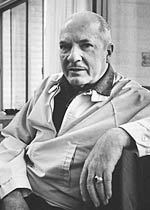 Of course, settling and attempting to farm a lifeless, freezing, lava-encrusted moonscape is going to be difficult and I guess you could expect this to happen, but then Heinlein piles on more. Disaster strikes the entire moon and nearly kills everyone and just as soon as we recover, Bill has a discussion with another settler/scientist who completely rocks his worldview. And right after that Bill stumbles on a discovery that changes everything he knows about the universe. I don’t want to give this away, but it gets pretty grim…and Bill handles it! Not handles it like some technology saves the day and “oh what a happy ending,” but he struggles with it internally and then consciously chooses to face a suddenly very foreboding future. How cool is that?! I thought it was great to see a young man deal with a problem in a way that most adults don’t. Read this kids!
Of course, settling and attempting to farm a lifeless, freezing, lava-encrusted moonscape is going to be difficult and I guess you could expect this to happen, but then Heinlein piles on more. Disaster strikes the entire moon and nearly kills everyone and just as soon as we recover, Bill has a discussion with another settler/scientist who completely rocks his worldview. And right after that Bill stumbles on a discovery that changes everything he knows about the universe. I don’t want to give this away, but it gets pretty grim…and Bill handles it! Not handles it like some technology saves the day and “oh what a happy ending,” but he struggles with it internally and then consciously chooses to face a suddenly very foreboding future. How cool is that?! I thought it was great to see a young man deal with a problem in a way that most adults don’t. Read this kids!
Recommendation
I really, really liked that Heinlein respected his younger readers enough to trust them to deal with some difficult topics. I’m a firm believer that adults expect too little of our younglings and while I’m not sure how I would have handled this in my early teens, I appreciated it now. Overall, if you’re in the mood for some juvenile fiction, Farmer in the Sky is definitely the way to go.
The Unconsenting Skies
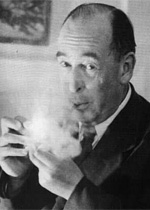 Here’s a followup of sorts to our first piece of C.S. Lewis verse, written “against too many writers of science fiction.” Despite being a rather successful science fiction writer himself, Lewis had a dark view of supposed scientific progress in general, as is clear from this pessimistic look into the future of space travel. Fans of Lewis’ more religiously-minded literature might be surprised at his frank imagery, but he wasn’t as shy about certain things as his readers. As with the previous installment, this bit of verse is available in his Poems collection.
Here’s a followup of sorts to our first piece of C.S. Lewis verse, written “against too many writers of science fiction.” Despite being a rather successful science fiction writer himself, Lewis had a dark view of supposed scientific progress in general, as is clear from this pessimistic look into the future of space travel. Fans of Lewis’ more religiously-minded literature might be surprised at his frank imagery, but he wasn’t as shy about certain things as his readers. As with the previous installment, this bit of verse is available in his Poems collection.
Prelude to Space
An EpithalamiumSo Man, grown vigorous now,
Holds himself ripe to breed,
Daily devises how
To ejaculate his seed
And boldly fertilize
The black womb of the unconsenting skies.Some now alive expect
(I am told) to see the large,
Steel member grow erect,
Turgid with the fierce charge
Of our whole planet’s skill,
Courage, wealth, knowledge, concentrated will;Straining with lust to stamp
Our likeness on the abyss—
Bombs, gallows, Belsen camp,
Pox, polio, Thais’ kiss
Or Judas’, Moloch’s fires
And Torquemada’s (sons resemble sires).Shall we, when the grim shape
Roars upward, dance and sing?
Yes: if we honour rape,
If we take pride to fling
So bountifully on space
The sperm of our long woes, our large disgrace.
GMRC Review: The Word for World is Forest by Ursula K. Le Guin
 Editor’s Note: Rhonda Knight is a frequent contributor to WWEnd through her excellent blog series Automata 101 and her new series Outside the Norm. This is Rhonda’s fourth featured review for the Grand Master Reading Challenge.
Editor’s Note: Rhonda Knight is a frequent contributor to WWEnd through her excellent blog series Automata 101 and her new series Outside the Norm. This is Rhonda’s fourth featured review for the Grand Master Reading Challenge.
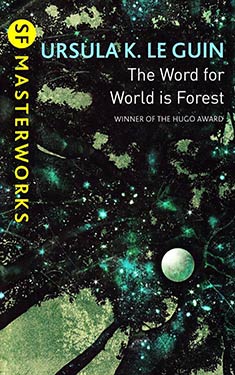 Many of the GMRC reviewers have noted that some books seem very much of their times. In fact, I commented in my review of Ray Bradbury’s The Golden Apples of the Sun that several of his stories seemed dated. In reference to Ursula K. Le Guin’s The Word for World is Forest, no observation could be more untrue. The novella upon which the novel is based won both the Nebula and Hugo Awards in 1973. The novella appeared in Harlan Ellison’s second New Wave anthology Again, Dangerous Visions in 1972. Le Guin published the novel version in 1976. However, with its focus on ethnic and ecological concerns, it seems as if it could have been written last year.
Many of the GMRC reviewers have noted that some books seem very much of their times. In fact, I commented in my review of Ray Bradbury’s The Golden Apples of the Sun that several of his stories seemed dated. In reference to Ursula K. Le Guin’s The Word for World is Forest, no observation could be more untrue. The novella upon which the novel is based won both the Nebula and Hugo Awards in 1973. The novella appeared in Harlan Ellison’s second New Wave anthology Again, Dangerous Visions in 1972. Le Guin published the novel version in 1976. However, with its focus on ethnic and ecological concerns, it seems as if it could have been written last year.
The novel takes place in New Tahiti Colony, on the planet Athshe. Terran workers have come to this tree-covered planet to harvest the trees and return them to Earth, which is mostly barren. In comparison, “New Tahiti was mostly water, warm shallow seas broken here and there by the reefs, islets, archipelagoes, and the five big Lands that lay in a 2500-kilo arc across the Northwest Quarter-sphere. And all those flecks and blobs of land were covered with trees. Ocean: forest. That was your choice on New Tahiti. Water and sunlight, or darkness and leaves” (15-16). Because this is one of Le Guin’s Hainish novels, the planet’s population was seeded by the Hains centuries earlier. The indigenous population are, of course, forest dwellers, but they took a very different evolutionary turn than their “cousins” the Terrans. The Athsheans are about a meter high with green fur. They look much like monkeys. The Athsheans have complex sleeping patterns, which involve multiple “naps” and lucid dreaming. The Terrans misinterpret the Athsheans’ biorhythms. At first they think that the Athsheans will make good slaves or members of the Voluntary Autochthonous Labor Corps (their euphemism) because they don’t sleep. Later the Terrans think that the Athsheans are lazy because they don’t realize that their “Voluntary Autochthonous Laborers” are napping rather than just sitting still and staring into space. This behavior leads the Terrans using verbal and physical violence to make their workers “productive.”
One of the best “motivators,” in his opinion, is Captain Don Davidson. He is one of the workers at the logging camp and is one of the of the three point of view characters in the novel. The second is Selver, a former Athshean slave who attacked Davison and then was allowed to escape by Captain Raj Lyubov, who is an anthropologist and the third point of view character. Davidson demonstrates the callous attitude towards nature that caused his Earth to become barren. He calls the indigenous population “creechies” and hunts the animals on the planet for sport. He sees himself as “a world-tamer”: (14). He thinks “it’s Man that wins, every time. The Old Conquistador” (15). Selver is not “a world-tamer” but “a world-changer.” He learns violence from the Terrans and teaches the Athsheans how to attack in order to save themselves and their world from the colonizing Terrans: “Selver had brought a new word into the language of his people. He had done a new deed. The word, the deed, murder” (124). Lyubov is the tragic middle man. He understands both cultures and sees each culture’s inability to interpret the other. The Terrans are too greedy and too stubborn to attempt to understand the “humanity” of the Athsheans, while the Athsheans, as the weaker colonized people, quickly decide that they must adopt the violent ways of the humans if they want to keep their world.
 This book is the perfect marriage of Le Guin’s interests in anthropology and ecology as well as her penchant for standing up and speaking out. In her introduction to the book, reprinted in The Language of the Night, Le Guin tells us that she wrote the novella in “pursuit of freedom” … but “succumbed, in part, to the lure of the pulpit” (151). She further describes her protests against the Viet Nam War during 1968. This text illustrates her frustration with the war itself but also with the amount of collateral damage the fighting caused to the Vietnamese eco-system and the non-combatants. Her motives were transparent then and have remained so over the years. For example, the book appears beside a bed in Stanley Kubrick’s Full Metal Jacket as a telling anachronism. The irony is: even though the book was partially engendered by one of the most significant events in the late twentieth century and even though Le Guin’s ex post facto introduction almost apologizes for its proselytizing tone, the book still speaks to the world of the twenty first century. In many ways this is unfortunate because this means there are still Don Davidsons in the world.
This book is the perfect marriage of Le Guin’s interests in anthropology and ecology as well as her penchant for standing up and speaking out. In her introduction to the book, reprinted in The Language of the Night, Le Guin tells us that she wrote the novella in “pursuit of freedom” … but “succumbed, in part, to the lure of the pulpit” (151). She further describes her protests against the Viet Nam War during 1968. This text illustrates her frustration with the war itself but also with the amount of collateral damage the fighting caused to the Vietnamese eco-system and the non-combatants. Her motives were transparent then and have remained so over the years. For example, the book appears beside a bed in Stanley Kubrick’s Full Metal Jacket as a telling anachronism. The irony is: even though the book was partially engendered by one of the most significant events in the late twentieth century and even though Le Guin’s ex post facto introduction almost apologizes for its proselytizing tone, the book still speaks to the world of the twenty first century. In many ways this is unfortunate because this means there are still Don Davidsons in the world.
I recommend the book highly. It is a quick read that will make you consider humanity in many of its lovely and gruesome forms. Le Guin gets the last word about this classic: “The work must stand or fall on whatever elements it preserved of the yearning that underlies all specific outrage and protest, whatever tentative outreaching it made, amidst anger and despair, toward justice, or wit, or grace, or liberty” (The Language of the Night 152).
10 Minutes of John Carter
So this is supposed to be the first 10 minutes of the movie. It feels more like a montage of scenes than 10 contiguous minutes to me but I like it pretty well. The production values are really good at least but it’s just a bit disjointed for my tastes. It’s like they’re trying to squeeze in too much back story into too little screen time so they can get on to Mars quicker. Guess I can’t blame them for that. I hope it evens out after the cave. Can’t wait for Saturday!
WWEnd Grand Master Reading Challenge: February Review Poll
Month 2 of the 2012 WWEnd Grand Master Reading Challenge is now complete and it’s time to vote on the featured reivews. Here are the numbers after 2 months: 80 participants, 134 books read and 48 reviews. Compared to last month we’re up 15 participants and 28 reviews while the total books read more than doubled!
Take a look at the 8 featured reviews below and be sure to cast your vote for the February GMRC Review of the Month!
- Darker Than You Think by Jack Williamson (charlesdee)
- Prelude to Space by Arthur C. Clarke (valashain)
- A Time of Changes by Robert Silverberg (Emil)
- The Golden Apples of the Sun and Other Stories by Ray Bradbury (Rhondak101)
- The Demolished Man by Alfred Bester (Scott Laz)
- The Big Time by Fritz Leiber (jfrantz)
- The Stochastic Man by Robert Silverberg (Allie)
- The Demolished Man by Alfred Bester (jfrantz)
We’ll keep the poll open until the 15th so you have plenty of time to read all the reviews you missed. Voting is open to all WWEnd members, not just challenge participants.
Good luck to everyone and thanks for the great reviews!
Update: Rhondak101 sent me these interesting stats to share with everybody:
Authors with the most books read:
- Isaac Asimov (13)
- Robert A. Heinlein (12)
- Ursula K. Le Guin (11)
- Joe Haldeman (11)
Authors with the most different titles read:
- Isaac Asimov (8)
- Robert A. Heinlein (8)
- Ursula K. Le Guin (6)
- Joe Haldeman (6)
- Ray Bradbury (6)
Authors without any books read yet:
Books most frequently read:
- Ursula K. Le Guin, The Dispossessed (5)
- Joe Haldeman, The Forever War (5)
- Alfred Bester, The Demolished Man (4)
- Alfred Bester, The Stars My Destination (4)
- Michael Moorcock, Behold the Man (4)
- 9 other books with 3 reads
The most read authors list should come as no surprise. These folks are all giants of SF/F. That we’re only shy 3 authors to be read after 2 months is pretty cool. It occured to me the other day that we should have made Damon Knight required reading for the challenge – the award bears his name after all. You’ll note that all of the most frequently read books are SF Masterworks. It seems you guys are doubling up on your challenges!



















 Full Details
Full Details


